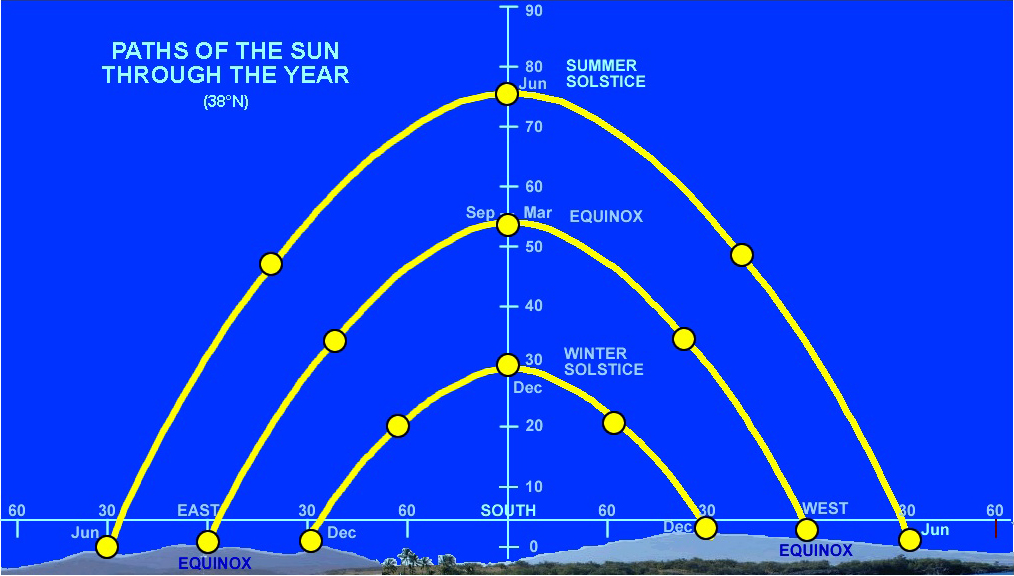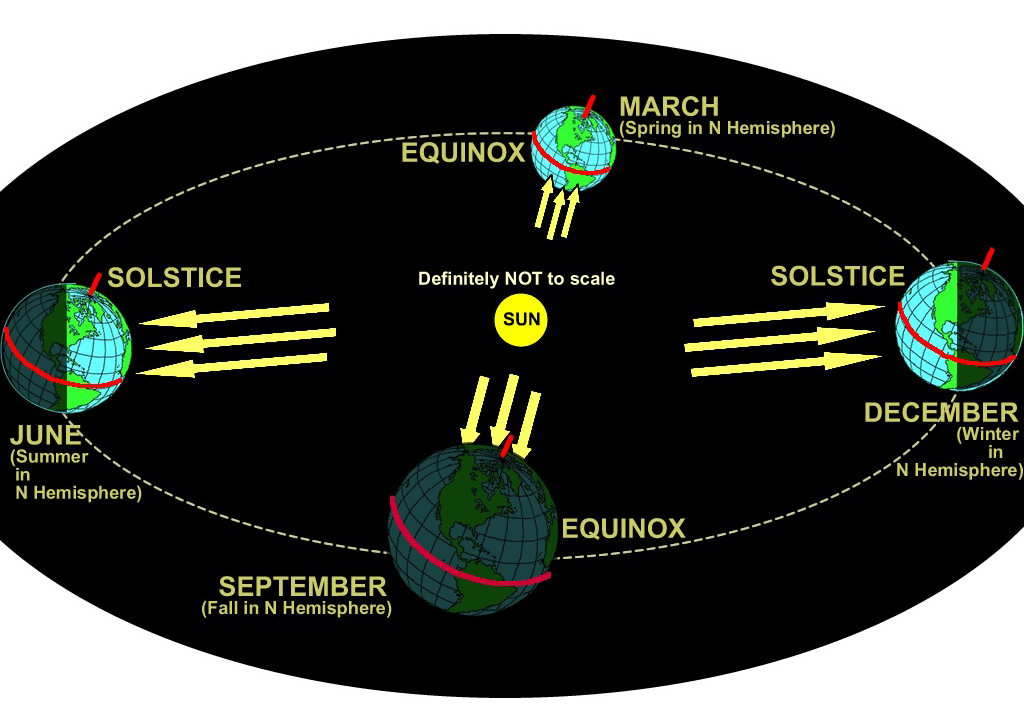The Sun as a Timekeeper
DIGITAL EFFECT: Summer Pre-Sunrise
Go to just before sunrise June 21st.
People have observed the Sun for thousands of years—they had to observe the Sun as a matter of survival.
Why would that be?
[Before we had nice wall calendars, the Sun helped keep track of the seasons, and critical times for planting crops.]
DIGITAL EFFECT: Summer Sunrise
Allow the audience to watch the Summer Solstice sunrise.Let’s watch the Sun as our most ancient ancestors did. Here we are, waiting for sunrise. I have set the planetarium sky to June 21.
Do you know anything significant about that date?
[This is the date of the summer solstice—the longest day of the year.]
Let’s watch and see where the Sun rises.
DIGITAL EFFECT: Summer Sunrise
Let Sun rise above the eastern horizon. Pause Sun just after rising.\
Take a look where the Sun rose, and let’s all remember that position in the northeast.
[Mark horizon position of sunrise.]
Now, where do you think the Sun is going to set?
DIGITAL EFFECT: Azimuth Horizon Projection
Activate an azimuth scale along the horizon for observing and marking where the Sun rises and sets.
The scales can be marked in degrees, or sections of the horizon can be labeled with letters or numbers.
Think about that as we let the Sun rise, and see if your neighbor agrees with you. Now, let’s see where the Sun sets.
DIGITAL EFFECT: Go to Sunset
Run Sun’s motion; pause before crossing the meridian.
Optional
The presenter may choose to distribute the “Where Does the Sun Go?” tracking sheet at this point.
Many will probably predict sunset at the diametrically opposite point, or predict due west.
The Sun first rises higher and higher, but eventually it reaches the highest point it is going to reach in the sky. The Sun reaches this highest point for the day when it crosses an imaginary North-South line called the meridian.
DIGITAL EFFECT: Meridian On
Activate the meridian. You need a flagpole projection that can be used to mark how high the Sun gets in the sky at noon in the different seasons. In your digital planetarium projection system, use the graphic with filename “Flagpole.png” in the “ProjectorMasters” folder of the PASS Media for this purpose.
DIGITAL EFFECT: Summer Noon
Allow the audience to watch as the Sun rises to its zenith. If possible, put a trail on the sun to show its path across the sky. Pause Sun’s motion when the Sun crosses the meridian.
Optional
Make a mark on your sheet at the appropriate place on the flagpole, and label it “June”
Here we have our planetarium meridian (or flag pole, if used). Let’s take note where the Sun is along the meridian.
All right—let’s let the Sun continue across the sky.
DIGITAL EFFECT: Meridian Off
Turn off the meridian.
DIGITAL EFFECT: Summer Sunset
Run diurnal motion until sunset. Keep sun trails on.
Optional
Mark on your sheet where the Sun set, and label that “June”.
Where did the Sun actually set?
[We can see that it set to the north of west.]
Is that where you predicted it would set?
[Maybe some of you thought it would set due west or maybe in the southwest. (Take any answers.)]
For now, note that the Sun actually set in the northwest.Mark horizon position of sunset.
DIGITAL EFFECT: Summer Night
Run diurnal motion to nighttime, astronomical twilight.So, here we see the stars of the midsummer’s night.
Can anyone find the seven bright stars of the Big Dipper?
[Take any answers.]
DIGITAL EFFECT: Ursa Major Pot
Invite the audience to point out the Big Dipper, and any other familiar constellations/asterisms.

Scorpius is a famous summertime constellation that should be visible too. Or, maybe someone can find the Summer Triangle—three bright stars making up a large triangle easily visible in the summer.
DIGITAL EFFECT: End Ursa Major Pot
DIGITAL EFFECT: Go to Sunrise
Continue to run diurnal motion until just before sunrise.And here we are back at morning.
Now, what if we were to change the date by a few months? Would the Sun rise at the same position along the horizon?
[Take any answers.]
Let’s use our planetarium as a time machine now and speed ahead three months into the future, to about September 21.
DIGITAL EFFECT: Autumnal Equinox
Crossfade to just before sunrise on September 23, 2015 (autumnal equinox).
Do you know something special about that date?
[It’s the date of the Fall Equinox when day and night are of equal length.]
DIGITAL EFFECT: Autumnal Sunrise Once again, take a look at where the Sun has risen now on September 21st.Mark horizon position of sunrise.
Note that the Sun has risen quite a bit further to the South than before—in fact it has risen due east. Where do you suppose the Sun will set? Make a mental prediction, and then check with your neighbor to see what they think.
One more thing: do you think the Sun will cross the meridian at the same level as before? Will it cross higher? Lower?
[Take any answers.]Allow audience to discuss new predictions.]
Let’s take a look.
DIGITAL EFFECT: Meridian On
Activate meridian projection.
DIGITAL EFFECT: Autumn Noon
Allow the Sun to reach its zenith.
Make a note of the Sun’s position on the meridian (mentally, or on their sheets with “September”)—and notice that it is lower in the sky than before.
Does that help you predict where the Sun will set? Does your neighbor agree with you?
DIGITAL EFFECT: Meridian Off
Turn off meridian.
DIGITAL EFFECT: Autumn Sunset
Run motion until sunset.
Were your predictions correct?
[Accept any answers, and have the audience mark their sheets with “September.”]
On September 21st, we see the Sun sets due west.
[Mark horizon position of sunset.]
DIGITAL EFFECT: Autumn Night
Run diurnal motion until nighttime.
DIGITAL EFFECT: Ursa Major Pot
Where is the Big Dipper now?
Notice it’s in a different part of the sky during this time of year—low towards the horizon. Notice also that Scorpius is gone, but now in the fall we can see new constellations like Andromeda and Pegasus.
Note the position of the Big Dipper and other seasonal constellations.
DIGITAL EFFECT: End Ursa Major Pot
DIGITAL EFFECT: Winter Solstice
Continue to run diurnal motion until more of winter sky is showing. Be ready to show the next sunrise.
Now let’s change the date one more time. If we skip ahead another three months, we’ll be at December 21st.
Does anyone know anything special about this date?
[It’s the date of the winter solstice, the shortest day of the year.]
DIGITAL EFFECT: Winter Sunrise
Change to December 21.
[Mark horizon position of sunrise.]
Note again where the Sun has risen—even further south on December 21st.
Now where do you suppose the Sun will cross the meridian? Higher now, or lower?
[Take any answers.] Allow audience to discuss new predictions.
DIGITAL EFFECT: Meridian On
Activate meridian projection.
DIGITAL EFFECT: Winter Noon
Allow the Sun to reach its zenith.

Make a note of the Sun’s position on the meridian(mentally, or on their sheets with “September”)—and notice that it is lower in the sky than before. Now, make one final prediction for where the Sun will set. Does your neighbor agree with you?
DIGITAL EFFECT: Meridian Off
Turn off meridian.
DIGITAL EFFECT: Winter Sunset
Run motion until sunset.
Were your predictions correct?
[Accept any answers, and have the audience mark their sheets with “December.”]
On December 21st, we see the Sun sets further towards the south, in the southwest.
[Mark horizon position of sunset.]
DIGITAL EFFECT: Winter Night
Run diurnal motion until nighttime.
Where is the Big Dipper now? Once again, it’s in a different part of the sky during this time of year—just above the northern horizon. Notice also that Andromeda and Pegasus are gone, but now in the winter we can see new constellations like Orion and Taurus.
DIGITAL EFFECT: Ursa Major Pot
Note the position of the Big Dipper and other seasonal constellations.
DIGITAL EFFECT: Winter Sky
Stop diurnal motion when you have a good winter sky.
DIGITAL EFFECT: End Ursa Major Pot
If we were to skip ahead another three months to March 21st, where do you think the Sun would rise?
[Further south? (Take any answers.)]
In fact, after the winter solstice, the Sun starts to rise further north each day.
Now, many of us learn that the Sun rises in the east and sets in the west.
Note:
You can travel to before sunrise on March 20th, 2009 — the vernal equinox. Have the audience simply point out their guesses for the spring equinox, instead of using horizon markers. Then you can continue with “Meridian On” and “Ursa Major Pot” effects as before, if desired.
But does the Sun always rise due east and set due west?
[No! We have just seen it does not.]
in fact, the Sun only does this on two days of the year—can anyone tell me when these days are?
[The Fall and the Spring equinoxes.]
DIGITAL EFFECT: Sun Paths
If possible, show the Sun trails in the sky.
VISUAL 2 (optional still): Sun Paths at Different Seasons

[Show an image that illustrates the paths of the Sun throughout the year. This image can be skipped if the presenter feels that the sun trails are enough of an illustration.] What we’ve observed the Sun doing is summarized in this picture. In the summer, the Sun rises and sets in the north, is higher in the sky at noon, and there are a lot more hours of daylight. In the winter, the Sun rises and sets in the south, is lower in the sky at noon, and there are a lot fewer hours of daylight.
Note:
The above are effects for a standard show. The presenter may wish to show the seasons in a different order. Optional effects may be used to customize the Sun Marking activity: The digital effects “Summer Solstice,” “Autumnal Equinox,” “Winter Solstice,” and “Vernal Equinox” may each run through the Sun Tracking activity in their respective seasons only. These provide the presenter with random access of the different seasons.
“Label Summer,” “Label Autumn,” “Label Winter,” and “Label Spring” effects may each show a label in the sky next to their respective Sun paths from the Sun Marking activity. “End Label” may hide the respective label.
“Sun Trails On,” “Sun Trails Off” effects may manually turn the sun trails on or off.
DIGITAL EFFECT: End Trail/Labels
Turn off all the Sun Trails and the Season Labels at the end of the Sun Marking activity. Alternatively, you may use label effects. Label all 3 paths, “All Labels On”, or you may use an individual label effect for each season.
VISUAL 3 (still): Seasonal Orbit
Show an image illustrating the reason for these different Sun paths and the reason for the seasons.

This picture shows how the sunlight shining on Earth changes through the year. It’s definitely not to scale.
Looking at the Northern Hemisphere in June, can you see how more of it is lit?
[Point to June Northern Hemisphere.]
See how the Sun might be higher in the sky, thus making more hours of daylight?
Parts of northern Alaska get 24 hours of daylight!
Looking at the Northern Hemisphere in December, can you see how less of it is lit?
[Point to December Northern Hemisphere.]
See how the Sun might be lower in the sky, with fewer hours of daylight?
Parts of northern Alaska get no daylight at all!
Ancient people kept track of the position of sunrise or sunset to keep track of the time of year. Many ceremonies and festivals were held at solstices and equinoxes.
Can you think of holidays that happen near, say, the winter solstice?
[Allow time for responses for different cultures and religions.]

